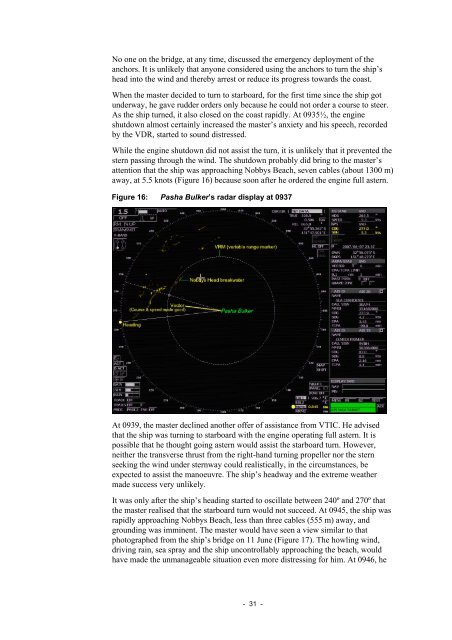Pasha Bulker 243 - Independent investigation into the grounding of ...
Pasha Bulker 243 - Independent investigation into the grounding of ...
Pasha Bulker 243 - Independent investigation into the grounding of ...
You also want an ePaper? Increase the reach of your titles
YUMPU automatically turns print PDFs into web optimized ePapers that Google loves.
No one on <strong>the</strong> bridge, at any time, discussed <strong>the</strong> emergency deployment <strong>of</strong> <strong>the</strong><br />
anchors. It is unlikely that anyone considered using <strong>the</strong> anchors to turn <strong>the</strong> ship’s<br />
head <strong>into</strong> <strong>the</strong> wind and <strong>the</strong>reby arrest or reduce its progress towards <strong>the</strong> coast.<br />
When <strong>the</strong> master decided to turn to starboard, for <strong>the</strong> first time since <strong>the</strong> ship got<br />
underway, he gave rudder orders only because he could not order a course to steer.<br />
As <strong>the</strong> ship turned, it also closed on <strong>the</strong> coast rapidly. At 0935½, <strong>the</strong> engine<br />
shutdown almost certainly increased <strong>the</strong> master’s anxiety and his speech, recorded<br />
by <strong>the</strong> VDR, started to sound distressed.<br />
While <strong>the</strong> engine shutdown did not assist <strong>the</strong> turn, it is unlikely that it prevented <strong>the</strong><br />
stern passing through <strong>the</strong> wind. The shutdown probably did bring to <strong>the</strong> master’s<br />
attention that <strong>the</strong> ship was approaching Nobbys Beach, seven cables (about 1300 m)<br />
away, at 5.5 knots (Figure 16) because soon after he ordered <strong>the</strong> engine full astern.<br />
Figure 16: <strong>Pasha</strong> <strong>Bulker</strong>’s radar display at 0937<br />
At 0939, <strong>the</strong> master declined ano<strong>the</strong>r <strong>of</strong>fer <strong>of</strong> assistance from VTIC. He advised<br />
that <strong>the</strong> ship was turning to starboard with <strong>the</strong> engine operating full astern. It is<br />
possible that he thought going astern would assist <strong>the</strong> starboard turn. However,<br />
nei<strong>the</strong>r <strong>the</strong> transverse thrust from <strong>the</strong> right-hand turning propeller nor <strong>the</strong> stern<br />
seeking <strong>the</strong> wind under sternway could realistically, in <strong>the</strong> circumstances, be<br />
expected to assist <strong>the</strong> manoeuvre. The ship’s headway and <strong>the</strong> extreme wea<strong>the</strong>r<br />
made success very unlikely.<br />
It was only after <strong>the</strong> ship’s heading started to oscillate between 240º and 270º that<br />
<strong>the</strong> master realised that <strong>the</strong> starboard turn would not succeed. At 0945, <strong>the</strong> ship was<br />
rapidly approaching Nobbys Beach, less than three cables (555 m) away, and<br />
<strong>grounding</strong> was imminent. The master would have seen a view similar to that<br />
photographed from <strong>the</strong> ship’s bridge on 11 June (Figure 17). The howling wind,<br />
driving rain, sea spray and <strong>the</strong> ship uncontrollably approaching <strong>the</strong> beach, would<br />
have made <strong>the</strong> unmanageable situation even more distressing for him. At 0946, he<br />
- 31 -
















